C.M. Rosens's Blog, page 31
April 22, 2022
Murder Will Out! Death of the Landlord (1730)
We’re still in the researching and exploration writing stage of the historical fiction slasher REDSTONE, or, the ‘Bloody Beach’ Murders, by Two Persons Intimately Acquainted With The Case, and I’m still finding lots of snippets that I don’t know if we can use or not. Little details like the poor missing lad who was found dead in a ditch eaten by dogs (boys, walk each other home) and various other gruesome and tragic things. Throwaway references to incidents like this are referencing these newspapers and pamphlets, just transposed to the fictional locality of the story setting [somewhere near Whitby/Robin Hood’s Bay in Yorkshire].
My search terms in the Eighteenth Century Collections Online have basically been things like “horrid murder” and “horrible murder” to see what I can get, and this popped up in an Edinburgh publication: MURDER WILL OUT, Or an Account of a horrible Murder committed several Years ago, on the Body of Sir Michael Balfour of Denmill which has been most wonderfully discovered a few Days ago.
The pamphlet page is below and my transcript is beneath.
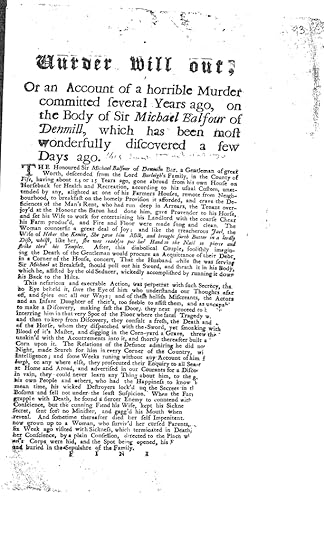 Murder will out, Or An account of a horrible murder committed several years ago, on the body of Sir Michael Balfour of Denmill, which has been most wonderfully discovered a few days ago
Murder will out, Or An account of a horrible murder committed several years ago, on the body of Sir Michael Balfour of Denmill, which has been most wonderfully discovered a few days agoDate: [1730]
Publisher: s.n. ([Edinburgh]) Full Transcript:
MURDER WILL OUT, Or an Account of a horrible Murder committed several Years ago, on the Body of Sir Michael Balfour of Denmill which has been most wonderfully discovered a few Days ago.
TL:DR VersionThe Honoured Sir Michael Balfour of Denmill Bar, a Gentleman of Great Worth, descended from the Lord Burleigh‘s Family, in the County of Fife, having about 14 or 15 Years ago, gone abroad from his own House on Horseback for Health and Recreation, according to his usual Custom, unattended by any, alighted at one of his Farmers Houses, remote from Neighbourhood, to breakfast on the homely Provision it afforded, and crave the Deficiencies of the Man’s Rent, who had run deep in Arrears, the Tenant overjoy’d at the Hononr [sic] the Baron had done him, gave Provender to his Horse, and set his Wife to work for entertaining his Landlord with the coarse Chear [sic] his Farm produc’d, and Fire and Floor were made snug and clean. The Woman counterfit a great deal of Joy ; and like the treacherous Jael, the Wife of Heber the Kenite, She gave him Milk, and brought forth Butter in a lordly Dish, whilst, like her, she was ready to put her Hand to the Nail to pierce and strike thro’ his Temples. After, this diabolical Couple, foolishly imagining the Death of the Gentleman would procure an Acquittance of their Debt in a Corner of the House, concert, That the Husband while she was serving Sir Michael at Breakfast, should pull out his Sword, and sheath it in his Body, which he, assisted by the old Seducer, wickedly accomplished by running it down his Back to the Hilts.
This nefarious and execrable Action, was perpetrat with such Secrecy, tha[t] no Eye beheld it, save the Eye of him who understands our Thoughts afar off, and spies out all our Ways ; and of these hellish Miscreants, the Actors and an Infant Daughter of their’s [sic] too, too feeble to assist them, and as uncapable to made a Discovery, making fast the Door, they next proceed to h [word is missing]
interring him in that very Spot of the Floor where the fatal Tragedy w [word is missing]
and then to keep from Discovery, they consult a fresh, the Death and [word is missing]
of the Horse, whom they dispatched with the Sword, yet smoaking [sic] with [the? word is missing]
Blood of it’s [sic] Master, and digging in the Corn-yard a Grave, threw the [word is missing]
unskin’d with the Acoutrements into it, and shortly after built a [word is missing]
Corn upon it. The Relations of the Defunct admiring he did not [word is missing – return that?]
Night, made Search for him in every Corner of the Country, wi[thout??] [word is missing]
Intelligence ; and some Weeks runing [sic] without any Account of him f[rom —??Edin-??]
burgh, or any where else, they prosecuted their Enquiry to all Sea-[word is missing]
at Home and Aroad [sic], and advertised in our Courants for a Disco[very??]
in vain, they could never learn any Thing about him, to the g[rief of???]
his own People and others, who had the Happiness to know [him??]
mean time, his wicked Destroyers lock’d uq [sic] the Secret in th[eir] Bosoms and fell not under the least Suspicion. When the Farm[er did??] grapple with Death, he found a fiercer Enemy to conntend [sic] with [word is missing] Conscience, but the cunning Fiend his Wife, kept his Sickne[ss] secret, sent for no Minister, and gagg’d his Mouth when [word is missing]
reveal. And sometime thereafter died her self Impenitent.
[The Daughter] now grown up to a Woman, who surviv’d her cursed Parents, six Weeks ago visited with Sickness, which terminated in Death, her Conscience, by a plain Confession, directed to the Place wh[ere Den-]mel’s Corps were hid, and the Spot being opened, his R[word is missing] and buried in the Sepulchre of the Family.
Sir Michael Balfour of Denmill rose out alone one day and visited a farming couple to demand rent from them, since they were in arrears. He also expected breakfast, so they made him some and the farmer and his wife murdered him (the farmer ran him through with a sword and used the same sword to slay Sir Micahel’s horse). He buried the horse in the corn-yard with all the accoutrements (saddle, bridle, etc) and buried the murdered landlord in the spot where he killed him, and planted crops on top.
The Farmer almost confessed at his death but the wife gagged him, kept his death a secret and didn’t send for a minister or doctor. She died later on. The couple’s daughter had been a very young child at the time of the murder but she knew all about it and confessed at her own death. She was clearly very young when she died, and “a woman” could refer to an older teen.
Sir Michael was discovered and entombed in his family sepulchre.
Sir Michael Balfour of Denmill: Family tree here (National Library of Scotland); some information on the House mentioned can be found in .
Jael, the Wife of Heber the Kenite: Biblical [Old Testament] allusion to a heroine in the Book of Judges, who saved Israel by defeating killing Sisera, commander of the opposing army, in her tent. She offered him hospitality to trick him into lying down and then drove a tent peg through his head as he slept.
The “Song of Deborah” (Judg. 5:24–26) recounts:
Extolled above women be Jael,
Extolled above women in the tent.
He asked for water, she gave him milk;
She brought him cream in a lordly dish.
She stretched forth her hand to the nail,
Her right hand to the workman’s hammer,
And she smote Sisera; she crushed his head,
She crashed through and transfixed his temples.
Here, as in the 14thC and Chaucer’s Canterbury Tales, Jael is not celebrated as a heroine but her actions are interpreted as wicked and treacherous, as it involves killing a man of higher status through subterfuge, which didn’t sit well within the British/English framework of feudalism and treason/treachery discourse, nor later in the class discourse and constructions of gender roles. This interpretation is divorced from the Biblical praise of Jael by her contemporaries and is rooted in fears and warnings of over-powerful women, seen to upend the social order. European artistic and literary depictions of Jael placed her in the ‘Power of Women’ topos, defined by Susan L. Smith as “the representational practice of bringing together at least two, but usually more, well-known figures from the Bible, ancient history, or romance to exemplify a cluster of interrelated themes that include the wiles of women, the power of love, and the trials of marriage”.[3] Smith argues that the topos is not simply a “straightforward manifestation of medieval antifeminism”; rather, it is “a site of contest through which conflicting ideas about gender roles could be expressed”.[4][5]
Here in this pamphlet, the author is taking this topos and applying it entirely negatively, although it is the husband who does the actual slaying.
the old Seducer : the Devil
save the Eye of him who understands our Thoughts afar off, and spies out all our Ways : God; the author is referencing Psalm 139:2-3.
concert : conferred together, consulted each other, made a plan together
yet smoaking with the Blood of its Master : as blood is body temperature, slaughtered animals (and people) can appear to steam as the warmth is let out (in winter, e.g), so you have the somewhat exaggerated, vivid descriptions of blood ‘steaming’ or ‘smoking’ in the air when it’s fresh.
Appreciated this post? Feel free to tip me on Ko-Fi!
April 20, 2022
Highwaymen Beset by Naked Victims! (1721)
I went looking for something less depressing than the horrific murders in the last two posts, so I hoped I’d find something that would at least make me laugh. I searched for ‘naked highwayman’ to see what I’d get. I didn’t get an actual naked highwayman (boo), but I did get this pair of disaster-bastards from Oxfordshire. Rooting for the naked and unarmed countrymen here.
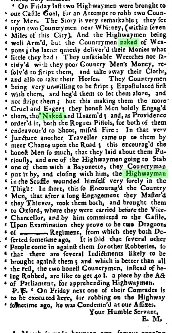 Saturday, Mar. 25, 1721
Saturday, Mar. 25, 1721Publication: (London, England)
Full Transcript:
On Friday last two Highwaymen were brought to our Castle Gaol, for an Attempt to robb two Country Men. The Story is very remarkable; they set upon two Countrymen in Whitney, (within seven miles of this City), And the Highwaymen being well Arm’d, but the Countrymen naked of Weapons; the latter quietly deliver’d their Monies what little they had : They unsatiable Wretches not satisfy’d with they poor Country Men’s money, resolv’d to stript them, and take away their Cloths, and also to take their Horses. They Countrymen being very unwilling to be stript ; Expostulated first with them, and beg’d them to let them alone, and not stript them ; but this making them more Cruel and Eager ; they honest Men boldly engag’d them, tho Naked and Unarm’d ; and, as Providence order’d it, both the Rogues Pistols, for both of them endeavour’d to Shoot, mis’d Fire : In that very Juncture another Traveller came up to them by meer Chance upon the Road ; this encouraged the honest Men so much, that they laid about them Furiously, and one of the Highwaymen going to stab one of them with a Bayonette, they Countryman put it by, and closing with him, the Highwayman in the Scuffle wounded himself very sorely in the Thigh : In short, this so encouraged the Country Men, that after a long Engagement they Master’d they Thieves, took them both, and brought them to Oxford, where they were carried before the Vice-Chancellor, and by him committed to the Castle. Upon examination they prove to be two Dragoons of ——- Regiment, from which they both Deserted some time ago. it is said that several other People come in against them for other Robberies, so that there are several Indictments likely to be brought against them ; and which is better than all the rest, the two honest Countrymen, instead of being Robbed, are like to get 40l. a piece by Act of Parliament, for apprehending Highwaymen.
P. S. On Friday next one of their Comrades is to be executed here, for robbing on the Highway some time ago, he was Condemn’d at our Assizes.
Your Humble Servant,
E. M.
Just picturing the absolute scenes of two well-armed dragoons being set upon by some naked guys, everything flapping in the breeze, as none of the Dragoons’ weapons actually work. I could make so many homoerotic jokes. So many. Please feel free to make them for me.
GlossaryWhitney: Witney, Oxfordshire, on the River Windrush. It’s within 12 miles of Oxford, though, not seven. Maybe he is measuring in country miles or something.
stript : strip/stripped, as in, strip them naked.
Providence : in this context, referring to the protective care of God, and discussions/understandings of its usage fits into a framework of discourse around fate vs free will, God’s providential actions and so on.
laid about them : beat them, attacked them
Bayonette : variant spelling of bayonet, a long, sharp blade that can be fixed to the end of a rifle and used as a weapon. In this case, the highwayman tried to use it without it being fixed, I guess, and ended up stabbing himself in the thigh. Lol.
Vice-Chancellor : Vice-Chancellor of Oxford University. This was Robert Shippen, who was VC from 1718-1723. See also: The Encyclopaedia of the University of Oxford (Hibbert, C. & Hibbert E. (eds) 1992, Papermac, London) The VC had more powers than just over the University, and in this case was able to exercise his jurisdiction by committing highwaymen to gaol (jail).
Dragoons : a member of any of several cavalry regiments in the British army. The name of the regiment is redacted in the printed piece to not bring it into disrepute/not get sued.
Deserted : left without leave. There are a few articles on desertion from the British Army in the eighteenth century, e.g. GILBERT, ARTHUR N. “Why Men Deserted from the Eighteenth-Century British Army.” Armed Forces & Society 6, no. 4 (1980): 553–67. http://www.jstor.org/stable/45346206. There’s an open access thesis on this topic by Ronnie Haidar, University of Windsor, CA: Desertion and Discipline: How British Soldiers Influenced the Military Justice System during the Seven Years’ War
40l. : £40. The ‘l.’ stands for ‘livres’, which is an Anglo-Norman throwback (post-1066). ‘s.’ stands for shillings, and ‘d.’ represents pence, but comes from the Latin ‘denarius’, and has been in use as an abbreviation since the Middle Ages. In 1720, the estimated buying power of £40 was the equivalent to roughly what £4,644.30 could buy you in 2017, according to the National Archives Currency Converter tool.
April 18, 2022
Inhumanity and Barbarity! Monstrous Mrs and Miss Branch of Hemmington, Somerset (1740)
Having discovered the case due to a throwaway line at the end of a report on the murderous mitten-knitter, Sarah Metyard, and her daughter Sarah Morgan Metyard, I decided to look for the case of Mrs and Miss Branch. It’s not in any of the newspapers, but there is a whole pamphlet on the case published in 1740 that gave me way more detail than I was hoping for.
Horrible well-to-do families deeply interest me, mainly because it bucks against the idea that horrific crimes of ‘barbarism’ are only committed by the uncivilised working class or the degenerate upper class, and that middle class characters cannot be effective as horror antagonists. This is more a very specific dig at the director of Eden Lake, who claimed that he chose a gang of hoodies for his antagonists because public schoolboys aren’t scary.
I take it he’s never (a) met a group of public schoolboys and (b) never read Lord of the Flies, but okay, it’s only scary when it’s working class and they live on a council estate, got it. Mrs and Miss Branch can’t be scary at all then. They only beat a lad so hard he —himself, then made him —- it. That’s not even what they’re on trial for.
Without further ado, may I present the content warnings for this post:
CWs: animal abuse, 14yo girl physically abused, food restricted, and beaten to death – details given, head injuries reported.
Additionally:
Details of Dr Salmon’s examination of the body are given, detailing the wounds and injuries, and testimony of abuse by Henry Butler, an ex-servant involving forced excrement-eating.
 Monday, May 19, 1740
Monday, May 19, 1740Publication: (London, England) Issue: 1737
Full Transcript of the Advert above:
This Week will be published, Price 6d.
INHUMANITY and BARBARITY not to be equall’d: Being an impartial relation of the barbarous murder committed by Mrs. Elizabeth branch and her daughter, on the body of Jane Buttersworth, their servant, at their farm at High-Church near Philips-Norton, in the county of somerset.
Containing also, I. A recital of the principal and material evience at their tryal at Taunton Assizes before Mr. Justice Chappel, on Friday the 4th of April, 1740.
II. The manner of the discovery of the murder.
III. The wonderful appearance of the light seen on the grave.
IV. The rising of the country people upon them as they went to take their tryal.
V. The particulars of their extraordinary execution at Ivelchester the third of May following, about four in the morning. Taken by a spectator.
Lastly, a copy of a letter sent by Miss Betty branch some small time before her execution, to the Rev. Mr. H- of Hemmington
Sold by T. Cooper, at the Globe in Paternoster Row.
This pamphlet INHUMANITY and BARBARITY is around 37 pages long and (Eighteenth Century Collections Online, a subscription service), sold for 6d. (sixpence) and detailing various aspects of the murder of Jane Buttersworth, a maid and apprentice to Mrs Elizabeth Branch.
Mrs Elizabeth Branch (67) was ‘a Gentlewoman of a considerable Estate in the parish of Hemmington’, Somerset. She had a daughter, Betty (24), a son who wasn’t there and doesn’t feature in the case, and was a widow at this point.
Her husband was an attorney at law known behind his back as The Devil of Belton. Before he married Elizabeth, he was a ‘man of considerable esteem in the world’ and after his marriage, ‘too closely adhering to the Temper and overruling Power of his Wife’ he became obnoxious and despised.
He made his money through corrupt and illegal means, and therefore was involved in several law suits himself, one of which was said to have brought about his death.
The pamphlet goes on to say that ‘His Wife was a Person who lov’d Money, and peculiarly remarkable for her Injustice, even in the lowest Circumstances of Life.’ Therefore, when her husband was confined at home following a court case that seemed to commit him to house arrest, he started having pricks of conscience about his ill-gotten gains and wanted to pay back his ‘unjust Debts’. His wife wouldn’t have that, and so Mr Branch suffered from a mysterious illness (according to the neighbours) where his body swelled up ‘in a surprising Manner’ and three coffins had to be made for it.
Obviously, the neighbours suspect foul play. They whispered that Elizabeth’s own mother was found hanging, which was suspected to be a ploy to cover her murder by making it look like suicide, so an investigation was not conducted. They also claimed that human bones were taken out of a sink or well close by one of the nearby farms, supposedly belonging to a servant girl of theirs who went missing some years before.
The extent to which this is all just a nasty whisper campaign, further sensationalised in the pamphlet to sell it at sixpence, is debateable. But this is what was discussed.
Other servants who had spent time at High-Church claimed that Elizabeth would deliberately mistreat them in order to make them desert their position, so that she could forfeit their wages.
Mrs Branch was also an avid reader, and her favourite things to read were those that treated with tyranny and inhumanity, such as the Emperor Nero, who ripped open his mother’s belly to see how he was born. From this, her daughter Betty ‘inculcated such barbarous Notions, that she would often cut open Mice and Birds, torturing them for three Hours together before they expir’d.’
Into this household comes the lively, ‘sprack‘ [alive, nimble, alert] Jane Buttersworth, a poor girl from Bristol, 14 years old. She was good with a needle and a good milkmaid, but was kept bare foot, bare legged and without a coat in winter and made to go out and milk the cows in this manner, and was not allowed to approach the fire in sight of Elizabeth or her daughter Betty. Like the other servants, she was allowed to eat only bread, cheese and water.
The details of the beating Jane/Jenny received on the day of her death are horrendous and prolonged, and she was made to work despite the severity of her injuries (including after being beaten repeatedly around the head), and it took her almost a full day to die from the injuries she received which seem to include a brain haemorrhage and internal bleeding. This was all because she had gone earlier that morning for a peck of bran, and was told by the sellers she couldn’t have it without the money. The son came over and told Elizabeth he hadn’t given the bran ‘because no one had come for it’, and this lie was what caused Jane to be beaten.
Jane had her head slammed repeatedly against the wall of the cowshed, and then was beaten face down on the floor with withy sticks until the sticks broke to stumps, with Betty kneeling on her neck to keep her down. She was then chased and whipped and cudgelled all around the house and out into the yard, bleeding and staggering, and then told to dust the house and continue her duties, despite bleeding profusely from deep wounds on her legs and arms and severe bruising all over her body. She gave all the visible signs of severe head trauma but tried to comply with her orders, but just couldn’t perform the duties she was supposed to do.
To revive her at one point as she was huddled in the corner with her head lolling onto her shoulder, another servant, Anne James, was told to get a plate of salt – when she tried to stand up for Jane, both mother and daughter flew at her and Elizabeth cried, “You Welch bitch, are you the Mistress or are you the Maid?” and so salt was brought and rubbed ferociously into the girl’s bleeding leg and buttock wounds to revive her with the smarting/stinging.
Jane was offered food at the same servant’s insistence, having not eaten since 5pm the previous day (it was now 4pm) but she couldn’t take it or eat it, and was struck again for that too, and then had her hands forced into a bucket of scalding water to do the dishes which scalded and shrivelled her skin.
The detailed description of Jane complaining about her vision and resting her head against the wall/doors repeatedly after the beatings, and her general disorientation etc is detailed in the account, and eventually she was carried up to her bed where she died.
They called for Dr Harris, but he couldn’t go so sent his son-in-law, Dr Palmer, instead. Dr Palmer observed the dead girl in bed (the Branches had changed her out of her bloody clothes and bloody cap), and he had been told she had fallen while carrying a heavy pail of water.
Mrs Branch later told him any wounds on her not consistent with this story were due to her being manhandled in the exhumation process. He said that this was easy to prove as he could scalp her to find out if the skull was fractured, and upon his honour he was not a man who could be bribed (wink wink), so Mrs Branch gave him a guinea for his trouble and the good Dr Palmer left without examining the body.
The mother and daughter had to lay out the corpse themselves, and the pamphlet details the putrefying wounds and blood etc., and wrapped her in a shroud and had her buried.
The Ghostly LightThe light is an interesting point and is one the pamphlet goes on to detail witnesses and their reports. Anne James was not quiet about the cause of Jane/Jenny’s death, but ghostly corroboration helped the neighbours decide to investigate the truth of Anne’s claims. This was put down to the fact that Mrs Branch was feared in the vicinity as a bad and litigious neighbour, so people were afraid to act against her without proof.
The ploughman first saw the light when he looked out of the window at the churchyard, and saw it appear at about 11pm over the grave of the murdered girl, then move to one end of the church, and then return to fix over the grave. When he called for his boy to look at it, it disappeared. A neighbouring butcher, Mr Clarke, saw it too.
Neither of them could say what had caused it and there was some conjecture as to whether it was ‘a Northern Meteor’ or someone in the churchyard with a candle in a lantern. Conjecture was that either Mrs Branch or Miss Betty Branch had gone out there at night to check on the grave, but the ploughman had not seen anything or anyone other than the light itself, and couldn’t say if that was the case – as did Mr Clarke.
The author/editor of the pamphlet suggested that it would be wise for someone local, who knew the parsonage overlooked the churchyard, to turn their backs and hide the light, not shine the lantern directly opposite. The author then adds that, either way, it was ‘a surprising Mark of Providence’, and ‘the Discovery of the whole Affair, bears the Testimony of the Hand of G O D, who perhaps judged it high Time to pluck them from off the Stage of Life, and make them ignominious Examples to all barbarous and inhuman People.‘ (p. 24)
The ExhumationNow that this light was seen, the neighbours seized this as a reason or omen to dig up the body quietly at night, determining that if nothing was amiss they would just re-inter her and nobody need find out she was exhumed. But, when they dug her up, she was not ‘in an offensive condition’ (links to martyrdom and the state of a saintly body here, perhaps), and so she was examined and the wounds came to light.
Most damning for some of them there was that the skin on her hands was still shrivelled as if in a tub of hot water all day, indicating that she had been forced to do the dishes as she was dying.
Dr Salmon, intrigued by the tales of the light, decided to be present at this exhumation so he would know the truth, and his testimony at the trial is reproduced in pp.28-9 of the pamphlet, since Dr Palmer, who was sent for at first, said that he did not examine Jane/Jenny’s body when he came to the house and pronounced her dead.
This is Dr Salmon’s testimony:
 p. 28
p. 28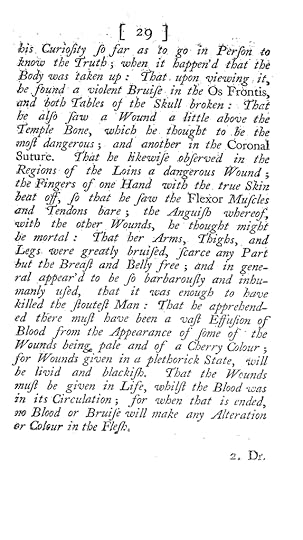 p .29
p .29Full Transcript of Dr Salmon’s Testimony:
I. Dr Salmon dispos’d to this Effect, That hearing of the Light on the Grave, it led his Curiosity so far as to go in Person to know the Truth ; when it happen’d that the Body was taken up : That upon viewing it, he found a violent Bruise in the Os Frontis, and both Tables of the Skull broken : That he also saw a Wound a little above the Temple Bone, which he thought to be the most dangerous ; and another in the Coronal Suture. That he likewise observed in the Regions of the Loins a dangerous Wound ; the Fingers of one Hand with the true Skin beat off, so that he saw the Flexor Muscles and Tendon bare ; the Anguish whereof, with the other Wounds, he thought might be mortal : That her Arms, Thighs, and Legs were greatly bruised, scarce any Part but the Breast and Belly free ; and in general appear’d to be so barbarously and inhumanly used, that it was enough to have killed the stoutest Man : That he apprehended there must have been a vast Effusion of Blood from the Appearance of some of the Wounds being pale and of a Cherry Colour ; for Wounds given in a plethorick State, will be livid and blackish. That the Wounds must have been given in Life, whilst the Blood was still in its Circulation ; for when it is ended, no Blood or Bruise will make any Alteration or Colour in the Flesh.
Elizabeth and Betty Branch were arrested, as was Anne James, and questioned. When brought to view the body, Elizabeth said she couldn’t see anything the matter with it, and that it didn’t bleed in her/her daughter’s presence (the folk belief being that a murdered body would bleed when touched by its killer/s). She also claimed not to know how the girl had come by her death.
When asked if Anne James had beaten the girl, Elizabeth said she’d never suffered a servant to beat a ‘prentice of hers in her life.
Anne James told the investigators the whole story.
After deliberation, the Jury of the Coroner’s court delivered a verdict of ‘Wilful Murder‘. The pamphlet mentions randomly in brackets that ‘(notwithstanding fifty Angels appear’d to the C—-r [Coroner?] on Buckland Downs)’ which seems to be a pretty pertinent supernatural detail…
Mrs Elizabeth and Miss Betty Branch were indicted for murder and everyone else was discharged. They were taken away from the Coroner’s court to Ivelchester Gaol for the murder trial to begin.
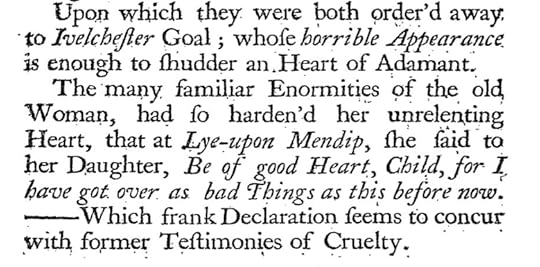 p. 26
p. 26Full Transcript of the snippet above:
Upon which they were both order’d away to Ivelchester Goal ; whose horrible Appearance is enough to shudder an Heart of Adamant.
The many familiar Enormities of the old Woman, had so harden’d her unrelenting Heart, that at Lye-upon Mendip, she said to her Daughter, Be of good Heart, Child, for I have got over as bad Things as this before now.
—– Which frank Declaration seems to concur with former Testimonies of Cruelty.
The people of the towns and villages along the way came out to see them being drawn to Gaol in the cart and pelted them with dirt and stones, and when they got to Lamport the cart broke down, so they had to walk the rest of the way. The townsfolk followed behind, throwing squibs and firecrackers, and pelting them with dirt and stones.
Mrs Branch turned and threatened them that if she got off (if she were found not guilty), she would sue the whole town.
Given Dr Salmon’s testimony (above) and the testimony of other ex-servants, this was not going to happen.
Henry Butler, previously a servant to Mrs and Miss Branch, was called to ‘prove the barbarous Temper of the Prisoners’ and he said he had witnessed them beating the Deceased and break her head for ‘slight Occasions’, and that they had often beaten him ‘barbarously ; – and once till he besh[a]t himself’, where upon the old Mistress held him while Miss Betty took the excrement out of his breeches, mixed it with ashes, and crammed it into his mouth.
The two sticks used to beat Jane/Jenny were produced in court, still covered in blood.
Mrs Branch stuck with the “she fell carrying a pail, like I told Dr Palmer” and that didn’t work, so they were pronounced guilty of murder, especially with Anne James’s testimony. Despite saying at the inquest she’d never suffered a servant to beat her Prentice, she had got bills against Anne James to pin the murder on her, but for some reasons the bills were not preferred.
The prosecutors also drew up a bill of indictment against the Coroner for perjury, but the Grand Jury was discharged before it could be preferred. [Was the Coroner Dr Palmer? I’m not sure about this part].
They were sentenced to death and given a month to prepare themselves for eternity. Miss Betty was badly affected by this, and her mother not at all:
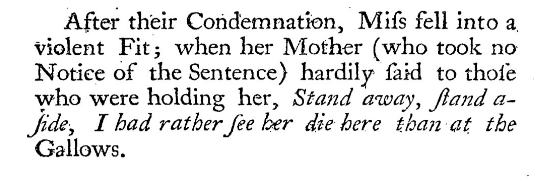 p. 33
p. 33Full Transcript of the Paragraph:
After their Condemnation, Miss fell into a violent Fit ; when her Mother (who took no Notice of the Sentence) hardily said to those who were holding her, Stand away, stand aside, I had rather see her die here than at the Gallows.
Stone cold, Elizabeth. Stone cold. Everyone else thought so too, and the pamphlet relates that ‘When the Judge was going out of Town, the People hung about his Coach, crying out, My Lord, Hang ’em! hang the old B[itc]h! And their Condemnation gave great Satisfaction to the Country all about.’
Some attempts to gain a pardon were made, especially for the daughter, but it was decided that she was the most barbarous of the two given that the beating had gone on for seven hours and was over something very trivial.
The ExecutionOn the day of the execution, the keeper of the Gaol was called up by the women themselves to take them as quickly as possible to the gallows so they could get it over with as privately as possible.
Elizabeth seemed sullen, but also in denial about the situation: she had complained about her dinner the night before and on the morning, caught hold of one of the Debtors’ arms and said she didn’t have her clogs, and she had to go back and get them or else she would catch cold.
Mrs Branch wore a black silk hood and her daughter Betty wore a large straw hat, and so they made their way to the gallows… only to find the townsfolk were having none of it, and had broken the gallows down and left one post standing, to delay the execution until a large crowd had the time to gather.
This didn’t make too much of a delay, though; a new gallows was erected by fixing two small trees and reattaching a noose. Betty Branch ascended first and fainted – her mother then put the rope around Betty’s neck herself while she was being held upright by the gaolers. Mrs Branch turned her head aside and said, Lord Jesus, must I see my Daughter hang’d! Then asked to kiss her child, but couldn’t as the halter was now fixed and a handkerchief placed over the daughter’s face. Mrs Branch then said, Good God! that ever I should come to so shocking an end! And promptly died ‘without the least seeming Ejaculation or Concern.’
There were around 200 spectators who were revelling in the scene and ‘instead of drawing Tears … there was rather a continual Scene of Joy.’
By 10am the town was full of angry people who had come for the execution and found they had missed it.
Betty’s LetterThe pamphlet closes with a letter from Betty to the Reverend, which is pretty extraordinary and I’ve included it here as a possible glimpse (if it’s real) of the character of Betty in her own hand/letter-writing voice.
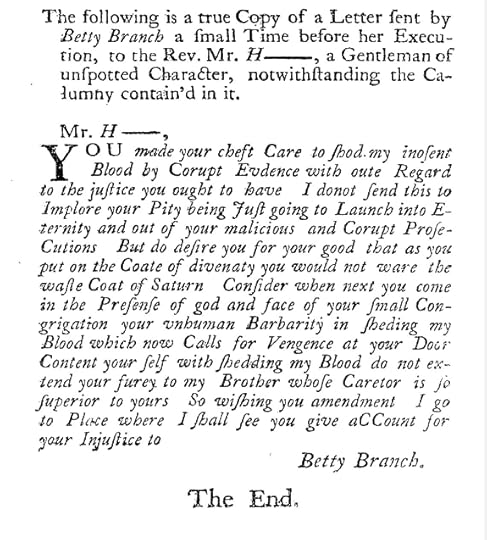
Full Transcript:
The following is a true Copy of a Letter sent by Betty Branch a small Time before her Execution, to the Rev. Mr. H——–, a Gentleman of unspotted Character, notwithstanding the Calumny contain’d in it.
Mr. H——,
You made your chest Care to shod my inosent Blood by Corupt Evidence with oute Regard to the justice you ought to have
I donot send this to Implore your Pity being Just going to Launch into Eternity and out of your malicious and Corupt Prosecutions
But do desire you for your good that as you put on the Coate of divenaty you would not ware the waste Coat of Saturn
Consider when next you come in the Presense of god and face your small Congrigation your unhuman Barbarity in sheding my Blood which now Calls for Vengeance at your Door
Content your self with shedding my Blood do not extend your furey to my Brother whose Caretor is so superior to yours
So wishing you amendment
I go to Place where I shall see you give aCCount for your Injustice to
Betty Branch.
Tidied up:
Mr. H——,
You made your chest Care to shed my innocent Blood by Corrupt Evidence without Regard to the justice you ought to have. I do not send this to Implore your Pity, being Just going to Launch into Eternity and out of your malicious and Corrupt Prosecutions, But do desire you for your good that as you put on the Coat of Divinity you would not wear the waste Coat of Saturn. Consider when next you come in the Presence of god and face your small Congregation your unhuman Barbarity in shedding my Blood which now Calls for Vengeance at your Door. Content your self with shedding my Blood do not extend your fury to my Brother whose Character is so superior to yours.
So wishing you amendment.
I go to [a/the] Place where I shall see you give account for your Injustice to
Betty Branch.
I shudder to think what Betty’s brother was like, but I wonder if he was a clergyman too by the tone of the letter.
Not sure how anyone survived in the eighteenth century at this point, but pretty sure the ones who did were scarred for life from whatever awful stuff had happened to them.
That’s the end of the Branch case!
If you’re appreciating the transcripts and research, feel free to tip me on Ko-Fi.
April 15, 2022
Sarah Metyard the Murderous Mitten-Knitter (1762)
This case is fairly horrendous, and involves a great deal of torture and stone cold callousness. I was looking for character inspiration and potential Awful Secrets for backstories for our awful characters in the 18thC Slasher WIP. We weren’t sure how dark we wanted to go, and ideas are being tossed around still, but I came across this horrific report and decided to inflict it on everyone else.
This case interested me because it is allegedly only the second ever time a mother and daughter were hanged together for the same murder, [the first time allegedly a Mrs Branch and her daughter, convicted of killing a maid of theirs in Somerset], and also because one of the reports notes that both their bodies were taken for dissection. Only bodies of those executed for the crime of murder could be legally used by anatomists, and this was one of the reasons demand for teaching materials outstripped supply and led to the rise of the professional bodysnatcher. Since this WIP came about out of a grain of an idea after listening to Romancing the Gothic’s double bill of body snatcher talks, this detail jumped out at me.
You can listen to Sarah Wise on the world of the London Bodysnatchers here and Suzie Lennox on the Relics of Bodysnatching here.
I’m going to look into the case of Mrs Branch and her daughter later on to see what that’s all about!
CWs for mistreatment and deliberate starvation, dismemberment, seizures and mother-daughter toxic relationship, and a double execution by hanging.
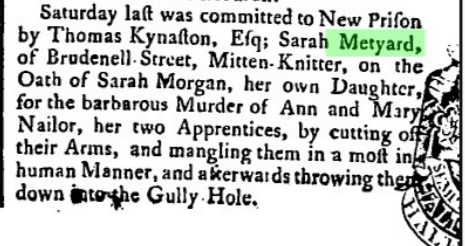 June 26, 1762 – June 29, 1762
June 26, 1762 – June 29, 1762Publication: (London, England) Issue: 203
Full Transcript:
Saturday last was committed to New Prison by Thomas Kynaston, Esq; Sarah Metyard, of Brudenell Street, Mitten-Knitter, on the Oath of Sarah Morgan, her own Daughter, for the barbarous Murder of Ann and Mary Nailor, her two Apprentices, by cutting off their Arms, and mangling them in a most in-human Manner, and afterwards throwing them down into the Gully Hole.
Ann Nailor’s murder was 4 years prior to the trial; Metyard tied Ann up and starved her to death. The Public Advertiser named Metyard as ‘Jane’ not ‘Sarah’, and only mentioned Ann and not Mary. [Monday, July 5, 1762, Publication: (London, England) Issue: 8632]
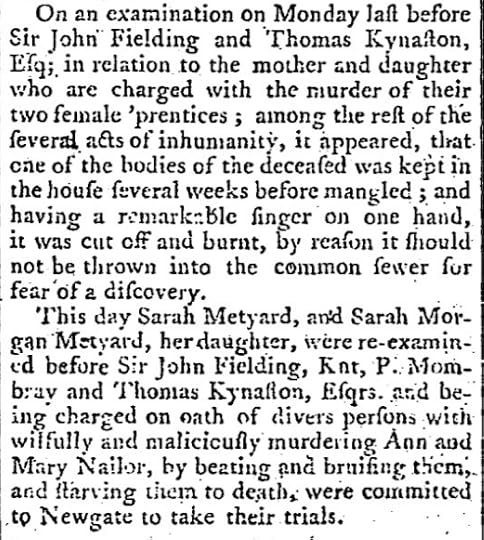 July 7, 1762 – July 9, 1762
July 7, 1762 – July 9, 1762Publication: (London, England) Issue: 778
Full Transcript:
On an examination on Monday last before Sir John Fielding and Thomas Kynaston, Esq; in relation to the mother and daughter who are charged with the murder of their two female ‘prentices ; among the rest of the several acts of inhumanity, it appeared, that one of the bodies of the deceased was kept in the house several weeks before mangled ; and having a remarkable finger on one hand, it was cut off and burnt, by reason it should not be thrown into the common sewer for fear of a discovery.
This day Sarah Metyard, and Sarah Morgan Metyard, her daughter, were re-examined before Sir John Fielding, Knt., P. Mombray and Thomas Kynaston, Esqrs. and being charged on oath of divers persons with wilfully and maliciously murdering Ann and Mary Nailor, by beating and bruising them, and starving them to death, were committed to Newgate to take their trials.
More details about the case and mistreatment of Ann, who was 13 years old, come out during the course of the trial, where Metyard’s daughter took the stand and tried to accuse her mother of the majority of the misdeeds in order to save herself. This didn’t go quite as planned.
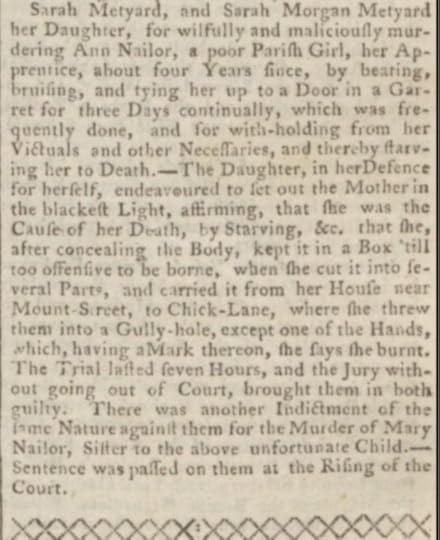 Thursday, July 22, 1762
Thursday, July 22, 1762Publication: (Bath, England) Issue: 41
Full Transcript:
Sarah Metyard, and Sarah Morgan Metyard, her Daughter, for wilfully and maliciously murdering Ann Nailor, a poor Parish Girl, her Apprentice, about four Years since, by beating, bruising, and tying her up to a Door in a Garret for three Days continually, which was frequently done, and for with-holding from her Victuals and other Necessaries, and there-by starving her to Death.
The Daughter, in her Defence for herself, endeavoured to set out the Mother in the blackest Light, affirming, that she was the Cause of her Death, by Starving, &c. that she, after concealing the Body, kept in a Box ’till too offensive to be borne, when she cut it into several Parts, and carried it from her House near Mount-Street, to Chick-Lane, where she threw them into a Gully-hole, except one of the Hands, which she says she burnt. The Trial lasted seven Hours, and the Jury without going out of Court, brought them in both guilty.
There was another Indictment of the same Nature against them for the Murder of Mary Nailor, Sister to the above unfortunate Child. —-Sentence was passed on them at the Rising of the Court.
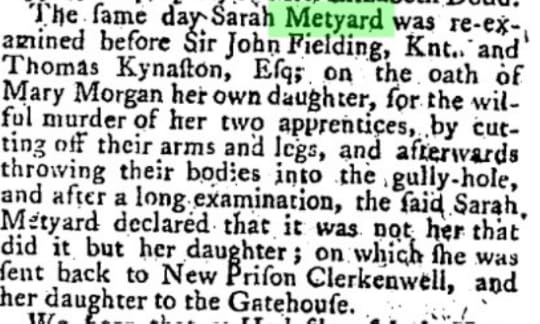 July 3, 1762 – July 6, 1762
July 3, 1762 – July 6, 1762Publication: (London, England) Issue: 863
Full Transcript:
The same day Sarah Metyard was re-examined before Sir John Fielding, Knt., and Thomas Kynaston, Esq; on the oath of Mary Morgan, her own daughter, for the wilful murder of her two apprentices, by cutting off their arms and legs, and afterwards throwing their bodies into the gully-hole, and after a long examination, the said Sarah Metyard declared that it was not her that did it but her daughter ; on which she was sent back to New Prison Clerkenwell, and her daughter to the Gatehouse.
(The names are all over the place in these reports, Sarah is called ‘Sarah Metyard’ and then ‘the said Anne Metyard’ in the same piece in the London Evening Post, the daughter is Sarah Morgan Metyard, but also Mary Morgan, but sometimes just Sarah Morgan. Names are flexible…)
In 1762, the case was written up in a pamphlet alongside a highwayman’s execution, entitled ‘‘. It’s available via Eighteenth Century Collections Online [ECCO], account required. The pamphlet includes the testimony of Philadelphia Dowley, 14 years old, who was ‘bound out’ by the parish of Tottenham High Cross to the mother, Sarah Metyard. Philadelphia said that Ann had tried to run away on account of being starved, but the milkman stopped her when Sarah and her daughter told him to, and Ann was taken back upstairs and beaten.
Note that at the time of trial, Sarah Morgan Metyard was nineteen years old, and so at the time of the murder four years previously, she would have been fifteen.
Philadelphia said it was the (then 15 year old) daughter who tied up Ann to the door, with the rope around her middle and her hands behind her so she could not sit or lie down, and untied her at night so she could go to bed. She asked her mother to help her tie Ann up, but her mother said, “No, if you will have your crotches; you may do them yourself.” (Crotch in this case relates to crotchet, meaning whim or fancy).
Philadelphia recounted calling down that Ann was ill and hung double from her rope, that she seemed dead to her, and the daughter came up and beat Ann with a shoe but she didn’t move. So she was untied and Philadelphia was sent downstairs with the two other apprentices, Mary Nailor, Ann’s sister, and Ann Paul, who was also no longer alive by the time of the trial.
Richard Rooker was apparently a lodger of Mrs Metyard’s some time after the murder of Ann Nailor, and took up with the daughter Sarah/Sally Morgan Metyard. When he moved out and took his own house, he took the daughter with him, and the mother made a big fuss about it, coming by and making a riot outside his house. On one occasion she broke in and threatened her daughter with a knife, and had given her a blow on the head. Rooker heard the daughter exclaiming, “Mother, you are the Chick-lane ghost; remember the gully-hole!” He asked her what she meant, and tearfully young Sarah/Sally told him that they had starved their apprentices to death and Ann Nailor was the first of them to be starved, and her body had been dumped in the open sewer in Chick Lane.
[Sarah was making a deliberate reference to the Cock Lane ghost story in her cryptic exclamation here; it features in the free-to-view Romancing the Gothic class on Spooks, Spectres and Frauds by Dr Sam Hirst.]
Rooker claimed the daughter was in the power of the mother, and frequently had scratches on her face, and that he and his sister were verbally abused by Mrs Metyard after he took Sarah/Sally in, but he could not prove that the abusive letters his sister received were written by the mother.
The pamphlet contains the full account of the daughter’s testimony (with the mother’s objections and interjections) and despite both mother and daughter calling character witnesses in their defence, all of whom gave them good ones, the jury returned a verdict of guilty in the case of Ann and sentenced both to death.
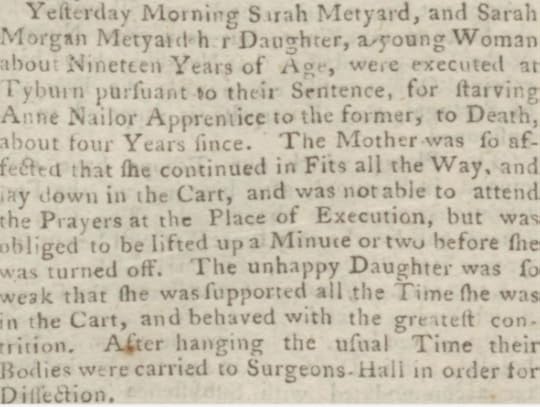 Thursday, July 22, 1762
Thursday, July 22, 1762Publication: (Bath, England) Issue: 41
Full Transcript:
Yesterday Morning Sarah Metyard, and Sarah Morgan Metyard her Daughter, a young Woman about Nineteen Years of Age, were executed at Tyburn pursuant to their Sentence, for starving Anne Nailor Apprentice to the former, to Death, about four Years since.
The Mother was so affected that she continued in Fits all the Way, and lay down in the Cart, and was not able to attend the Prayers at the Place of Execution, but was obliged to be lifted up a Minute or two before she was turned off.
The unhappy Daughter was so weak that she was supported all the time she was in the Cart, and behaved with the greatest contrition.
After hanging the usual time, their Bodies were carried to Surgeons Hall in order for Dissection.
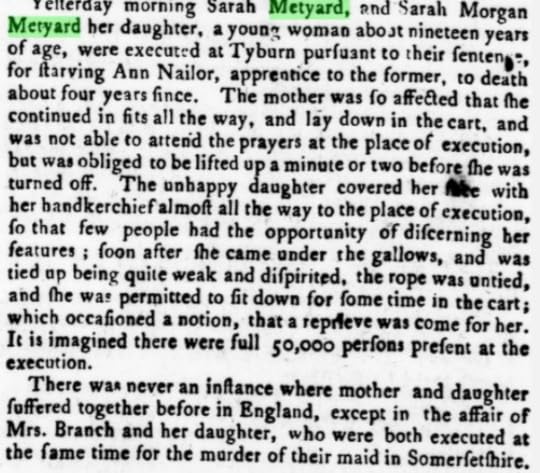 Tuesday, July 27, 1762
Tuesday, July 27, 1762Publication: (Leeds, England) Volume: 9 , Issue: 433
Full Transcript:
Yesterday morning Sarah Metyard, and Sarah Morgan Metyard her daughter, a young woman a young woman about nineteen years of age, were executed at Tyburn pursuant to their sentence, for starving Anne Nailor, apprentice to the former, to death about four years since. The mother was so affected that she continued in fits all the way, and lay down in the cart, and was not able to attend the prayers at the place of execution, but was obliged to be lifted up a minute or two before she was turned off.
The unhappy daughter covered her face with her handkerchief almost all the way to the place of execution, so that few people had the opportunity of discerning her features ; soon after she came under the gallows, and was tied up being quite weak and dispirited, the rope was untied, and she was permitted to sit for some time in the cart ; which occasioned a notion, that a reprieve was come for her. It is imagined there were full 50,000 persons present at the execution.
There was never an instance where mother and daughter suffered together before in England, except in the affair of Mrs Branch and her daughter, who were both executed at the same time for the murder of their maid in Somersetshire.
I’m pretty sure that mother-and-daughter hangings took place in England during the Witch Trials, but I can’t think of a case off the top of my head and might be wrong about that? Regardless, I’m looking into the Mrs Branch case too!
Like this? You can buy me an eldritch item to keep me motivated (and non-Euclidean)
Otherwise known as tipping me on Ko-Fi
April 13, 2022
Golden Age of Piracy ~ Snippets of News
Inspired by Our Flag Means Death, I thought I’d see what piracy was reported on in the 18thC newspapers. I wasn’t disappointed. I’ve chosen a small selection that had some interesting details, all from the Stamford Mercury 1716-17.
I’ve included a glossary after each snippet for anyone not familiar with the terminology or variant spellings, and some notes on the cargo and money where amounts are mentioned.
If you are enjoying the series and want to show your appreciation, you can buy me an eldritch item if you’d like! Better than coffee, twice as wriggly, all the delicious.
CW: some description of severe injuries, threats to life, slave trade.
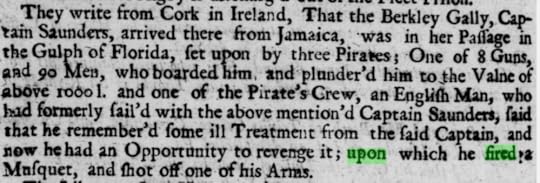 Sunday, Dec. 27, 1716
Sunday, Dec. 27, 1716Publication: (Stamford, England) Volume: VIII , Issue: 27
Full Transcript:
They write from Cork in Ireland, That the Berkley Gally, Captain Saunders, arrived there from Jamaica, was in her Passage in the Gulph of Florida, set upon by three Pirates ; One of 8 Guns, and 90 Men, who boarded him and plunder’d him to the Value of above 1000 l. and one of the Pirate’s Crew, an English Man, who had formerly sail’d with the above mention’d Captain Saunders, said that he remember’d some ill Treatment from the said Captain, and now he had an Opportunity to revenge it ; upon which he fired a Musquet, and shot off one of his Arms.
Notes & Glossary:
Gally : variant spelling of Galley, a ship propelled mainly by oars as opposed to sails.
Gulph of Florida: variant spelling of Gulf of Florida
three Pirates: three pirate ships
1000 l. : 1000 livres, or £1000 – The National Archives Currency Converter is a tool that helps you understand the comparative buying power of amounts of money based on the inflation rate in 2017 (UK). According to this tool, the buying power of £1000 in 1720 was roughly the equivalent of £116K in 2017.
Musquet : spelling variation of musket
 Sunday, Apr. 4, 1717
Sunday, Apr. 4, 1717Publication: (Stamford, England) Volume: IX , Issue: 14
Full Transcript:
The Grey-hound Galley of London, Capt. Evans, from Guniey, is arrived at Jamaica, having been plunder’d by a Pyrate of all her Gold Dust, Teeth, and 40 Slaves. The Pyrates have plunder’d several Ships near that Island.
Notes & Glossary:
 By RootOfAllLight – Own work, CC BY-SA 4.0, https://commons.wikimedia.org/w/index.php?curid=87684881, Walter Kennedy’s flag, based on the description by Capt. J. Evans of the Greyhound Galley which appears in THE HISTORY OF PIRACY.
By RootOfAllLight – Own work, CC BY-SA 4.0, https://commons.wikimedia.org/w/index.php?curid=87684881, Walter Kennedy’s flag, based on the description by Capt. J. Evans of the Greyhound Galley which appears in THE HISTORY OF PIRACY. Grey-Hound Galley: Not to be confused with the HMS Greyhound (there were a lot of ships called this) launched in 1712 and was mainly on trade protection duties in the Mediterranean and in Home waters. She was captured by the Spanish in 1718 off the coast of Morocco and burned in 1719, whereas this Greyhound was in active service later than 1719.
Capt. J. Evans of the Greyhound Galley described the pirate flag of Walter Kennedy pictured left. Evans was succeeded by Capt. Peter Solgard who had command of the Greyhound the following year.
There is an extended report from Capt. Peter Solgard of the Greyhound in 1723 in the British Journal, detailing his encounter with pirates on a sloop called the Ranger. The British Journal reported that pirates caught by Capt. Solgard were hanged with the Black flag, ‘affix’d to one corner of the gallows’. The report reads, ‘This Flag they called Old Roger, and us’d to say, They would live and die under it.‘ Saturday, Oct. 19, 1723 Publication: (London, England) Issue: 57, p. 19.
Guniey : Guinea, West Africa
Teeth : Some false teeth were made of ivory (also human teeth pulled from donors or the dead, and porcelain), so it’s likely that ivory dentures are what’s being referred to here, given that the ship is coming from Guinea, West Africa.
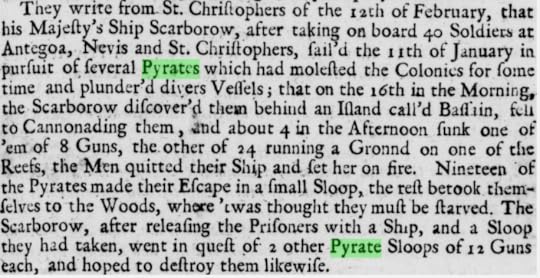 Sunday, Apr. 18, 1717
Sunday, Apr. 18, 1717Publication: (Stamford, England) Volume: IX , Issue: 15
Full Transcript:
They write from St. Christophers of the 12th of February, that His Majesty’s Ship Scarborow, after taking on board 40 Soldiers at Antegoa [Antigua], Nevis and St Christopher’s, sail’d the 11th of January in pursuit of several Pyrates which had molested the Colonies for some time and plunder’d divers Vessels ; that on the 16th in the Morning, the Scarborow discover’d them behind an Island call’d Bassain, fell to Cannonading them, and about 4 in the Afternoon sunk one of ’em of 8 Guns, the other 24 running a Gronnd [sic] on one of the Reefs, the Men quitted their Ship and set her on fire. Nineteen of the Pyrates made their Escape in a small Sloop, the rest betook themselves to the Woods, where ’twas thought they must be starved. The Scarborow, after releasing the Prisoners with a Ship, and a Sloop they had taken, went in quest of 2 other Pyrate Sloops of 12 Guns each, and hoped to destroy them likewise.
Notes & Glossary:
The Scarborow: HMS Scarborough, named after the town in England, launched in 1711. She was the second smallest class of warship (known as a “fifth rate” ship) and in Feb 1717 (a month after this reported event took place) was in the vicinity of Blackbeard and his crew near Nevis.
molested : here in the sense of plagued, bothered, made repeated attacks/raids on, etc
divers : variant spelling of ‘diverse’, in sense of various, many
Cannonading : shooting at them with cannons
Sloop : type of sailing boat with a single mast and one headsail; it should not be confused with a sloop-of-war, which in the British navy was a warship with a single gun deck.
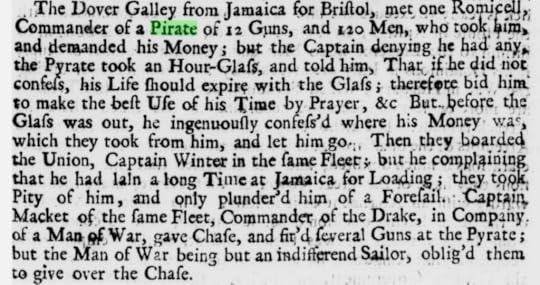 Sunday, Sept. 26, 1717
Sunday, Sept. 26, 1717Publication: (Stamford, England) Volume: X , Issue: 12
Full Transcript:
The Dover Galley from Jamaica for Bristol, met one Romicell, Commander of a Pirate of 12 Guns, and 120 Men, who took him, and demanded money ; but the Captain denying he had any, the Pyrate took out an Hour-Glass, and told him, Thar [sic] if he did not confess, his Life should expire with the Glass ; therefore bid him to make the best Use of his Time by Prayer, &c But before the Glass was out, he ingenuously confess’d where his Money was, which they took from him, and let him go. Then they boarded the Union, Captain Winter in the same Fleet ; but he complaining that he had lain a long Time at Jamaica for Loading ; they took Pity of him, and only plunder’d him of a Foresail. Captain Mackett of the same Fleet, Commander of the Drake, in company of a Man of War, gave Chase, and fir’d several Guns at the Pyrate ; but the Man of War being but an indifferend [sic] Sailor, oblig’d them to give over the Chase.
Glossary:
Hour-Glass : variant spelling of hourglass, or sand timer
ingenuously : the old (now obsolete) meaning is noble, honourable ; it also means showing innocent or childlike simplicity and candidness, lacking craft or subtlety. The older meaning is implied here, possibly, since the framing of the report does not seem to paint the Captain of the Dover in a negative light.
Foresail : the principle sail of the foremast.
Man of War: Not a specific kind of ship but a general Royal Navy term for any heavily armed warship or frigate from the 16-19thCs. Propelled by sails as opposed to a Galley, propelled mainly by oars. It ALSO refers to a heavily armed man or soldier, and a ship full of Men of War became known as a Man of War Ship. Unclear whether this is a man of war that’s not fast enough at sea to keep up with the pirate ship and was outrun, or whether Capt. Mackett was in company with an individual soldier (a man of war) who was not a good sailor and so obliged them to give up the chase on account of being too seasick to be any use/some other mishap occurred on account of his poor sailing ability.
indifferend : variant or misspelling of indifferent ; the usual meaning is ‘mediocre’ but in this context means ‘not very good’/’not up to the task’.
give over : an expression meaning ‘give up’ ; colloquially, “Give over!” is an expression meaning a range of things, but mostly along the lines of, “Stop teasing me/I don’t believe you” and used to express mild annoyance, surprise or joking good humour.
April 11, 2022
Panic! At the Farmhouse (1752)
In looking for events from the 18thC to play with in our co-written HistFic Slasher, REDSTONE, I came across this longer report of a break-in near Chester and thought this would be a good story to share on here.
I chose this one because:
(1) it’s wild – how did anyone survive the 18thC, good grief
(2) there’s a lot going on here, and the report seems to emphasise the villainy of the Irish which should be put into context of the hiberno-phobia of the time
(3) the family are the Porters but are the heroes this time
(4) one of the serving girls involved is Welsh and mentioned right at the end, unsurprising given the county’s demographic but it made me feel a bit more connected to the story
(5) Liverpool is mentioned and a ship bound to the West Indies and I’ve just recently taught a course that touched on Liverpool’s connections with the slave trade, so that context is relevant here too.
Chester is on the Anglo-Welsh border (the dotted line on the map below.)
I will do a bit of the context on Irish migration, 18th C Hibernophobia, and Liverpool’s connections with the West Indies at the end, after the transcript of the report. I’ve kept the original spelling and punctuation, but where the report double-spaces a sentence in lieu of starting a new paragraph because of space constraints, I’ve actually started a new paragraph just to break it up and make it easier to read.
Maps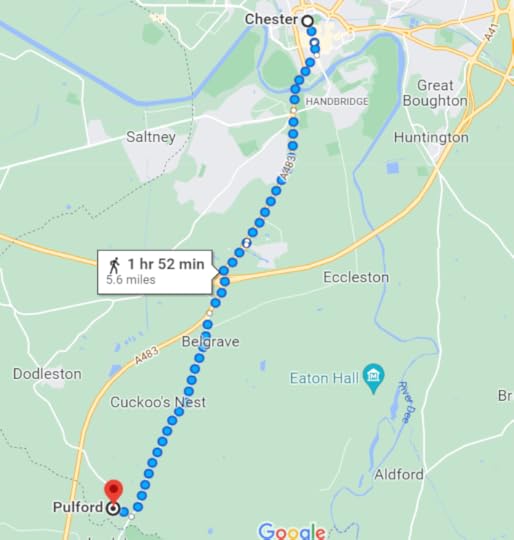 Margaret Porter rode from the Raike to her brother’s at Pulford, so the Raike farm was somewhere in the middle of Chester and Pulford? The farm was 2 miles from Chester, and 2 miles from Pulford, so presumably somewhere in the middle there.
Margaret Porter rode from the Raike to her brother’s at Pulford, so the Raike farm was somewhere in the middle of Chester and Pulford? The farm was 2 miles from Chester, and 2 miles from Pulford, so presumably somewhere in the middle there. 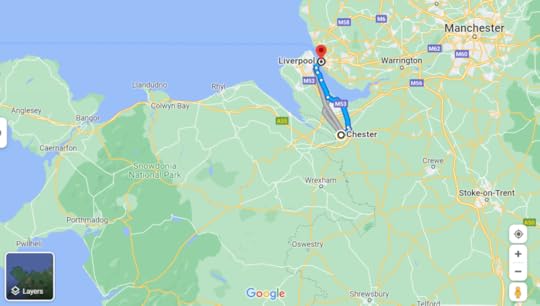 Google Map showing location of Chester and Liverpool, where one of the gang fled after the incident
Google Map showing location of Chester and Liverpool, where one of the gang fled after the incidentThe following story was told in detail by The Scots Magazine (Edinburgh), printed on Tuesday, Feb. 1, 1752, Vol. XIV.
Brief Notes on this StoryIrish Migration and Hibernophobia in Britain
At eight in the evening of Feb. I., five Irishmen (three of whom call themselves Richard Stanley, Edward Maccanally, and Patrick Boyd), armed with pistols, cutlasses and clubs, came to the Raike, a farm-house, two miles from Chester ; and opening the door, which was only latched, Stanley advanced briskly to John Porter the master, then at supper with his eldest daughter Eleanor, pointed a pistol towards him, and with dreadful oaths and imprecations threatened instantly to blow his brains out, if he did not deliver his money.
Then the rest of the gang rushed into the house, and bound the poor man with cords ; and having pinioned the daughter, obliged her to go up stairs with them.
Mean while the youngest daughter Margaret, about twelve years of age, who had at first sunk under a table through fear, stole out by the back door, locked it, and took the key along with her ; then went to the stable, got astride upon the only horse not haltered, and not daring to pass by the house, which was beset by the rogues, rode over the fields and ditches, to Pulford, two miles off, to call for her eldest brother.
Upon which, he and one Craven set out immediately.
The villains, after having been some time up stairs, came down to Mr Porter, who remained bound ; and Stanley said to Maccanally, “Stand fast, and blow his brains out, or by —- I’ll blow out your’s [sic].” They then searched his pockets, and took out about 14l. [£14] ; and Mr Porter declaring, that he had received that day at Chester the sum which he expected, and which they insisted upon ; in order to a further discovery of money, they stripped down his breeches to his feet, dragged him toward the fire, and shewed an intention to lay him on it.
The eldest daughter on her knees begging his life, Stanley damned her, saying, they would burn him first, and her afterwards.
At that instant the son and Craven arrived ; and, though quite unarmed, rushed into the house. The son collared one of the villains, knocked up his heels, and with much difficulty wrested his cutlass from him ; and Craven, having seised a club, was not idle on his part.
One of the villains perceiving the daughter going to unbind her father, levelled a pistol at her ; but as he pulled the trigger, one of his own comrades was jostled between him and her, who receiving the shot in his breast, shrieked and dropt down dead. At the same time two other pistols were fired. The son had then quite mastered Stanley, the master of the gang ; and the daughter having unbound her father, he so heartily joined his son and Craven, that the three remaining rogues were glad to break through a window, and fly.
Young Porter, after securing his prisoner, hastened to Chester bridge, with his friend, and seized two more of the villains. The three Irishmen were the next day committed to Chester jail.
The fourth escaped to Liverpool, and went on board a vessel, of which his brother was cook, bound for the West Indies, and the ship got under sail ; but, the wind changing, was forced back.
The King’s boat, on searching the vessel, discovered the fellow by his wounds ; and he and his brother were sent in irons to Chester castle ; as was also another Irishman, Mr Porter’s hired servant, whom the rogues at first coming pinioned, but unbound afterwards, after securing his master ; and he continued an unconcerned spectator during the whole affair, and after it ran away.
Mr Porter, his son, a servant-boy, and a Welch girl, were wounded.
Irish stereotypes were very negative and often fuelled by religious antipathy. Irish migration to Britain was met with rhetoric of ‘swamping’, anti-Catholic vitriol and prejudice, fears of negative political impacts, job competition, and the usual alarms and dog-whistles around “cultural degeneration”. The rhetoric and concerns were amplified as migration waves increased, and were especially vehement by the 1830s and 1840s. It’s important to note that these 19thC attitudes weren’t born in a vacuum, but had the solid foundation of anti-Irish sentiment and negative stereotypes going back to the Middle Ages and the first attempts at conquest and colonisation by the Cambro-Norman and Anglo-Norman lords.
James VI of Scotland and I of England had displaced a large number of the population in the north of Ireland with Scottish Protestants in a deliberate programme of plantation and settlement, and in the mid-17thC Oliver Cromwell had gained the nickname ‘the Butcher of Ireland’ for his genocidal campaign to re-conquer Ireland after the 1641 rebellion.
So a report on the villainy of the Irish served the feelings of the time, and helped to cement the negative ideas about what happens when Irishmen work together, especially given the context of a risk of a more united Ireland regaining a collective sense of nationhood around this time.
Some Articles for Further ReadingThe Rise of a New Ireland (1691-1750)
An Irish Parliament (1750-1800)
The Irish in Early Industrial Britain: George Cornewall Lewis’s Report (1830-1850)
A London Slum: Irish Migration and its Threat (1860-1870)
This report was dated 1752, so the ship bound for the West Indies in this report was certainly off to import a load of cargo from the plantations, and Liverpool was a major port for not only West Indian produce, but also directly involved in the transatlantic slave trade.
In 1700 Liverpool was a middling-sized fishing port with a population of 5,000 people. By 1800, 78,000 people lived and worked there, with thousands finding work because of the Transatlantic slave trade, building and equipping ships, and also in banking and accountancy from the money made by trafficking enslaved people. This continued even after Abolition – the 1807 Act had made it illegal to purchase slaves directly from the African continent, but slavery was only formally abolished in 1833. Ships still imported goods from the West Indies plantations that used enslaved people as workers, despite activists lobbying against this, which took the form of national boycotts of sugar and other demonstrations.
Although Liverpool merchants engaged in many other trades and commodities, involvement in the slave trade occupied the whole port. Nearly all the main merchants and citizens of Liverpool, including many of the mayors, were involved.
During the latter part of the 18th century, Liverpool was making about £300,000 a year from the slave trade. The rest of Britain’s slave trading ports put together made about the same amount again. In the 1780s Liverpool-based vessels alone carried more than 300,000 Africans into slavery. By 1795 Liverpool controlled over 60% of the British and over 40% of the entire European slave trade.
ResourcesLiverpool Museums : The Transatlantic Slave Trade (Background, Projects, Resources)
Liverpool Museums : Liverpool and the Slave Trade (History of Liverpool, Archive Resources, Bibliography, Links)
April 8, 2022
The Mayfair “Ghost” (1770)
This one is pretty funny, no cannibals or gore here, and I did a tweet thread about it earlier this month. I discovered this story in the London Post, Aug. 1770. I came across it while looking up other stories for the co-written 18thC Slasher WIP (working title: REDSTONE) research.
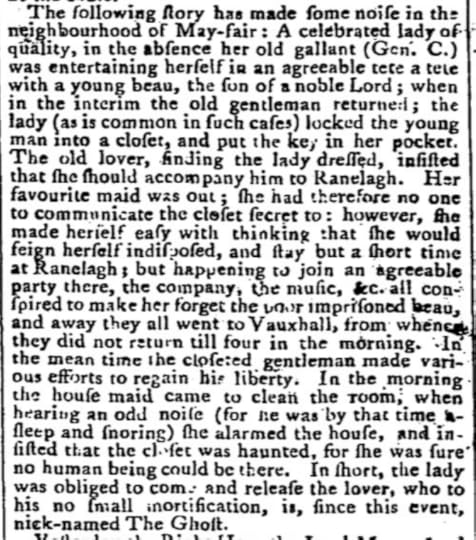
Full Transcript:
The following story has made some noise in the neighbourhood of May-fair: A celebrated lady of quality, in the absence of her old gallant (Gen. C.) was entertaining herself in an agreeable tete a tete with a young beau, the son of a noble Lord; when in the interim her old gentleman returned; the lady (as is common in such cases) locked the young man into a closet, and put the key in her pocket. The old lover, finding the lady dressed, insisted that she should accompany him to Ranelagh. Her favourite maid was out; she had therefore no one to communicate the closet secret to: however, she made herself easy with thinking that she would feign herself indisposed and stay but a short time at Ranelagh; but happening to join an agreeable party there, the company, the music &c. all conspired to make her forget her imprisoned beau, and away they all went to Vauxhall, from whence they did not return until four in the morning. In the mean time the closeted gentleman made various efforts to regain his liberty. In the morning the house maid came to clean the room, when hearing an odd noise (for he was by that time asleep and snoring) she alarmed the house, and Insisted that the closet was haunted, for she was sure no human being could be there. In short, the lady was obliged to come and release the lover, who to his no small mortification, is, since this event, nick-named The Ghost.
This one just made me laugh, and I think requires no detailed discussion! Hope you enjoyed it too! I think my favourite line is “as is common in such cases”, which absolutely creased me. So many lads locked in closets. Just a standard drill.
GLOSSARYMay-fair: Mayfair, the affluent district in London.
closet: a large wardrobe, possibly like one of these.
old gallant: her admirer, beau, in this case a General in the British Army (Gen. C.) – the paper only gives his initial but that would be enough for most of the social circle to know exactly who this referred to.
Ranelagh: Ranelagh Pleasure Gardens were set up to rival Vauxhall, but there was nowhere to get a decent drink (tea or coffee was fine) and no gambling.
Vauxhall: Vauxhall Pleasure Gardens were accessible across the river by boat, which at night must have been a more exciting start to the evening’s entertainment, and walks in the gardens were well-lit but also had a mix of more secluded places for promenading or slipping off for something naughtier.
April 6, 2022
Hungarian Cannibal Gang: 1782 (Part 2 of 2: The Story)
Now we’ve delved into the sources and a bit of context, here’s a version of this story rewritten from the British newspaper reports! This is not the story “as it happened”, and I’m also not really interested in whether this was hysteria or not, this is just my own version of the story as a more readable account. I’ve also included my own musings, inferences, extrapolations and theories, which should be taken with a pinch of salt.
[Note the British reports don’t mention ethnicity of the gang, but an article that came out in The County magazine Nov. 1787 which claimed they were Roma, or that this was the claim of German newspapers, and that in Hungary there was already a presumption that the Roma were cannibals. That article also claims around 100 people were executed for cannibalism in 1782-83 but we also know Joseph II ordered a stay of executions when they got to 45, while 100+ were still imprisoned, so I’m not sure if this is the case or a misunderstanding/inflated figures.
This is not what was reported in the British papers, as we’ve seen in the previous post, so this connection doesn’t feature in the previous post or in my attempt to chronologically piece the story together from the letters and dramatic sensationalist reporting, below. The reason that the British papers don’t identify the gang as Roma is possibly that Hungary is sufficiently Other in the British imagination as it is, and contemporary reports also include stories of survival cannibalism in Russia, so cannibalism is something that the British public can imagine happening in the forests of Eastern Europe already, by the Hungarians themselves. Lots of layers of xenophobia/racism in play here…]
For more information on Early Modern constructions of race and Roma history, see A Bit Lit 14 with Dr Sydnee Wagner, and Dr Wagner’s talk on Race, Romani and the Gothic.
The Cannibal GangOnce upon a time in a deep, dark wood, somewhere in Hungary, a gang around 150+ strong roamed the territory and based themselves in a subterranean lair, 50ft below the ground. They lay in wait for people on the roads, killed them outright or sexually assaulted them before killing them, and then butchered and roasted them to eat. Sometimes they roasted people alive, and musicians among them played their instruments to mask the sound of the screams.
Some were forced into the gang, others went of their free will, others were born into it, and together they killed and ate around 84 people over a 21 year period. The cannibal feasts would have ensured the bonding to the rest of them of those conscripted against their will, as once that act had been committed, they were as guilty as all the others in the eyes of the law.
Given the relatively small number of cannibalised victims for such a large gang over a 21 year period, it seems likely that it wasn’t a daily staple but for special occasions and bonding feasts, or that the gang members fluctuated over this period with not all the members active at the same time, but a core group with adherents and satellite members who were involved seasonally or for a certain period of time and then dropped off, e.g. working with other gangs at certain times within a loose criminal network.
The core group of the gang were probably related by blood and marriage, and were just as ruthless towards one another as they were to the strangers they murdered and robbed. At least one, but why not several, was some kind of Bluebeard/Mr Fox figure who cut the throats of his wives to eat his unborn babies from the womb like an extreme Hungarian Cronos/Saturn, while other men killed and ate their own parents for Reasons (hostile takeover, ritual, just for fun, hazing challenge, who knows). But their preferred meat for taste were girls around 15/16 years old.
On one occasion there was a wedding in the cave-lair, and for this, three pretty young country girls were captured, abused, and butchered for the wedding feast; they were devoured with glee by all present including the women of the gang and the bride herself.
Finally, in the summer of 1782, two thieves were caught and put on trial. One of them exhibited signs of great emotional turmoil while being sentenced, and the Judge decided this was a man with a guiltier conscience than originally thought. He pretended to have information of a greater crime against the pair, pulling out a random paper from his pocket that allegedly proved this, and threatened them with torture if they didn’t confess.
To the Judge’s surprise and horror, they confessed not just to murder, but to being part of a gang that roasted and ate the flesh of their victims. Troops were dispatched and initially 13 people were arrested and executed at Frauenmarckt.
The Captain of the gang evaded capture in that initial sweep, but a soldier approached the Judge and requested he be given some peasants to arm and take with him into the forest because he knew where the Captain might be hiding out, but like, really vaguely. So his plan is to go into the forest and head for the really vague sort of area and scout about for a bit and see if he can find him.
The soldier armed a couple of peasants with sabres and pistols and went off into the forest. Just under 2 hours later, they came upon the Captain of the gang with two of his loyal men just sort of… hanging about? [There’s not a single part of the Soldier’s story that I don’t have trouble with, to be honest, it just sounds so made up?]. The Captain was incredibly conspicuous in the dark forest by the incredible, bejewelled, gold lace cap he wore, worth 6000 florins alone. While he and his men were villainously jingling their pockets full of gold in the middle of the forest for no reason, the brave Soldier fired off a shot and everyone – all of his well-armed peasants (more than 2) and both (2) the rough tough cannibal killers – legged it in different directions. The Captain obviously didn’t and shot at the Soldier but missed, so the Soldier wrestled him to the ground and managed to get his knee on the Captain’s throat so he could reload his pistol/light the other pistol and shoot the returning Villainous Rogues, dropping one of them. Fortunately, the Soldier’s useless but heavily armed peasants were still within hearing range and he yelled at them to come back so they could help/witness him taking all the credit, and they returned to secure the Captain while the remaining gang member ran off again.
The Soldier delivered the Captain to the judges, his pockets still full of gold that he was just carrying about in the forest for no reason, and was handsomely rewarded while the peasants presumably got nothing but a cursory ‘well done/no thanks to you, lads’ and were sent back to wherever they came from.
I’m going to pause right there because I’m calling shenanigans. In my totally made-up head canon version, this is clearly a classic double-cross. The Provost Marshall is obviously being paid off by these guys, and the Soldier of the Provost Marshall’s court is aware of a pre-arranged meeting with the Captain for this purpose. Off goes the Soldier with his peasants to capture the gang, the peasants do all the work and he takes all the credit. That’s also a good story.
Back to the source material. Following the capture of the Captain there is a further spate of confessions and another sweep of the forest, which meant that hundreds of people – estimates ranged between 120-281 – were imprisoned across Hungary wherever there was space to hold them.
The number of executions for murder and cannibalism reached 45. All sorts of stories are reported now, and they reach the ears of the Holy Roman Emperor, Joseph II, himself, and he can’t believe that such ruffians exist in the world, so he orders a stay on executions and sends his own investigators to the spot to see if what they are saying is true.
[At this point, of course, we would begin the grimdark Gothic Horror novel/film/series, with the investigator as the protagonist, coming from the Enlightened Urban Centre into the wilds of the deep dark superstitious forest to explore the subterranean systems of nature and the human mind, etc. Elements might include the corruption of ‘civilised’ officials, shamanistic cannibalism, witchcraft – capital punishment for which crime has been suspended by this point – and come up against all sorts of horrifying antisemitic, antiziganist, anti-pagan prejudice, rhetoric and responses. The whole thing is very dark and disturbing, featuring themes of generational trauma and abuse, sexual assault/gender-based violence, etc.]
And that seems to be the story? It’s absolutely wild, and I think I’m on Team Joseph II in questioning whether this ever happened or it’s a Crucible situation with some really over the top confessions and the same kind of hysteria surrounding witch hunts and werewolf trials.
For those interested, there’s an actual ‘Unwittingly Bonded into a Villainous Family via a Cannibal Feast’ scene in Eldritch Girls Just Want To Have Fun, co-written with Ezra Arndt, followed by the same character having hallucinations in an Orthodox Church where he perceives the Eucharist wafers as actual flesh of the actual Christ-child, so he feels thrown from one cannibal feast to another and doesn’t know what’s real or whether one cancels out the other, or which feast he would prefer to partake of. That bubblegum splatterpunk/eldritchcore book, with all its religious trauma, gruesome murder, Europop references and bisexual angst, is probably coming out in 2023 now but you can add it to GoodReads while you wait.
Enjoyed the post? Feel free to tip me on Ko-Fi! It’s much appreciated – and a one-off tip gets you access to all my Ko-Fi exclusive One-Off Supporter posts for 30 days.
April 4, 2022
Hungarian Cannibal Gang Case: 1782 (Part 1 of 2: The Sources)
In my research for the 18thC Slasher WiP I’m co-writing, now titled REDSTONE; OR, THE ‘BLOODY BEACH’ MURDERS, I came across a case of a cannibal gang reported in the Reading Mercury under the Foreign Affairs section. This article is the extended version of the report that came out in July 1782, detailing the execution of 13 people for murder and cannibalism. This more sensational report came out in August, but was printed in the paper in October, presumably taking into account the time it took letters to reach Reading, England, from Buda(pest), Hungary at this time.
 Extract from the Reading Mercury, Wednesday’s Post: Foreign Affairs, Monday Oct. 7, 1782
Extract from the Reading Mercury, Wednesday’s Post: Foreign Affairs, Monday Oct. 7, 1782CWs for sexual assault/rape, murder, infanticide, patricide, cannibalism, graphic descriptions: read on with caution.
The full report reads:
Wednesday’s Post. Foreign Affairs. Buda (capital of Hungary) Aug. 7.
Wednesday’s Post: Foreign Affairs: Reading Mercury (Reading, England) Monday, Oct. 7, 1782, Issue 1080. Punctuation preserved from the original in my transcription.
In our last letters we mentioned, that at Frauenmarckt [Women’s Market], on the 21st of last month, thirteen villains had been executed, who for upwards of twelve years past assassinated on the highways, and fed upon the flesh of the unfortunate people they had murdered. The whole of that article wants additions. It is very true that only thirteen have been executed at Frauenmarckt : but, both in that place and other parts of Hungary, 40 have already been put to death, both men and women, all cannibals, all devouring the flesh of the unhappy people who had fallen into their hands ; and near 120 more wait the same just fate, in the different prisons of Hungary. These monsters have declared, that at a wedding, which they were celebrating amongst themselves in a subterraneous place, upwards of 50 feet deep from the surface of the ground, in the midst of a dark thick wood, they had first abused, one after another, three pretty young country girls, whom they had carried off ; that they had afterwards cut their throats, then roasted, then devoured them with glee ; and that the bride, as well as the other women of the gang, had all fed upon them. They declared that, of all human flesh, the best is neither under, nor above the age of 15 or 16 years ; they have eat the flesh [sic] of 84 different persons in the space of 21 years, during which they have exercised their horrible depredations. They assure that the bones of their dead carcases, which they burnt, made the best charcoal in the world. Some of these wretches have been hanged, some broke on the wheel, some quartered, some burnt, according to the rank they held among themselves, their age, and their manner, either free, or forced, by which they had aggregated together. Their Captain was taken in the following manner :— A soldier of the Provost Marshall’s Court, knowing partly the situation of the haunt of these cannibals, went to the Judges of Frauenmarckt, and promised to deliver up to them the chief of the gang, if he was assisted by some peasants. They were given him : He armed them and himself with sabres and pistols, and they pushed on into the forest. They had not marched two hours before they espied three men, one of whom was richly dressed, and wore a cap a la pandoure, loaded with gold lace and jewels, and perceiving them also, fired a pistol, which happily missed them ; his two comrades fled at the sight of the peasants, without even firing ; the peasants did the same, while the soldier, who had bravely seised [sic] the robber by the throat, brought him to the ground, and was disarming him. His two comrades, seeing nobody left there but the soldier, turned back. He was then in great danger, but he had the strength to keep the villain down , with his knee upon his throat, while with his right hand he fired off a pistol, which brought one of the men to the ground ; at the sight of which the other took to his heels. The soldier then called out, as well as he could, after the peasants, who happily were still within hearing, and appeared again, but dropping in one by one ; the robber was bound, and carried to Frauenmarckt, where he was committed to prison. He had his pockets full of gold, and the ornaments of his cap alone were worth above 6000 florins. It is assured the soldier will be handsomely rewarded.
This story was circulating in various newspapers that autumn; the month before (September 1782) it was carried by Parker’s General Advertiser and Morning Intelligencer (London), 30 Sept 1782, Issue 1850, but I found it in the Reading Mercury first and liked the drop cap it used, so that’s the screengrab I’ve shared!
The Public Advertiser had the following printed in its 15091 Issue, Wednesday 09 Oct 1782, subheading Extract of a Letter from Vienna, Sept. 18.:
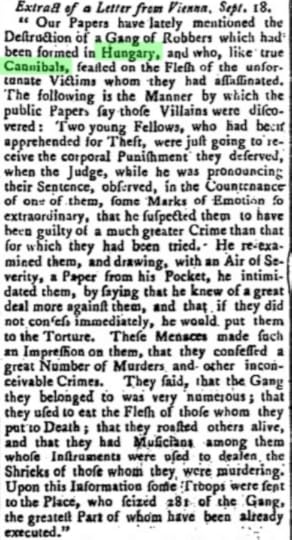
Full Transcript of the above image:
Extract of a Letter from Vienna, Sept. 18.
Our Papers have lately mentioned the destruction of a Gang of Robbers which had been formed in Hungary, and who, like true Cannibals, feasted on the Flesh of the unfortunate Victims whom they had assassinated. The following is the Manner by which the public Papers say those Villains were discovered : Two young Fellows, who had been apprehended for Theft, were just going to receive the corporal Punishment they deserved, when the Judge, while he was pronouncing their Sentence, observed, in the Countenance of one of them, some Marks of Emotion so extraordinary, that he suspected them to be guilty of a much greater Crime than that for which they had been tried. He re-examined them, and drawing, with an Air of Severity, a Paper from his Pocket, he intimidated them, by saying he knew of a great deal more against them, and that if they did not confess immediately, he would put them to the Torture. These Menaces made such an Impression on them, that they confessed a great Number of Murders and other inconceivable Crimes. They said, that the Gang they belonged to was very numerous ; that they used to eat the Flesh of those whom they put to Death ; that they roasted others alive, and that they had Musicians among them whose Instruments were used to deafen the Shrieks of those whom they were murdering. Upon this Information some Troops were sent to the Place, who seized 281 of the Gang, the greatest Part of whom have already been executed.
Capitalisation and punctuation of the original has been preserved in my transcription.
In this letter, the number of the gang has massively increased from 120 to 281, and the tale of the capture of the gang leader by the soldier is not told – the credit instead goes to the shrewd judge for forcing a confession from two petty thieves he deemed too emotional for the crime they were accused of and presumed (correctly) they were guilty of something far worse. The language here and emphasis on Marks of Emotion shown by one of the thieves feels as though it’s drawn from a Gothic novel, as does the ploy to exact a confession. The additional details of the musicians using their music to cover the shrieks of the victims is a particularly colourful one, and ties into the subterranean wedding imagery of the first report.
But wait. There’s more.
The London Post covered this in Jan 11, 1783:
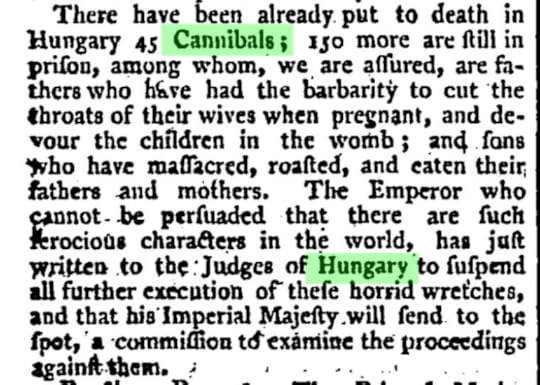
Full Transcript of the above image:
There have been already put to death in Hungary 45 Cannibals ; 150 more are still in prison, among whom, we are assured, are fathers who have had the barbarity to cut the throats of their wives when pregnant, and devour the children in the womb ; and sons who have massacred, roasted, and eaten their fathers and mothers. The Emperor who cannot be persuaded that there are such ferocious characters in the world, has just written to the Judges of Hungary to suspend all further execution of these horrid wretches, and that his Imperial Majesty will send to the spot, a commission to examine the proceedings against them.
Punctuation and Capitalisation of the original preserved in the transcription.
This feels like it’s getting a bit out of hand at this point. The number has fluctuated again in this report, now saying that 150 people were imprisoned, allegedly, and 45 executed, which doesn’t quite reach the 281 figure of the previous articles. This story now positions the gang as interconnected through familial bonds and instead of killing strangers, details the horrific murders of one another in the closest bonds of 18th century ‘nuclear’ family. [I know that’s probably not the right term for the time, but that’s the closest one I can find to describe it! Let me know if there’s a better one in the comments, as family structures have too much nuance in the 17th and 18thC s for ‘traditional’ to be used here, which also renders concepts of ‘nuclear’ more complex than married couples and parents!]
 Joseph II, Holy Roman Emperor, by Anton von Maron – Kunsthistorisches Museum Wien, Bilddatenbank., Public Domain, https://commons.wikimedia.org/w/index.php?curid=4892099
Joseph II, Holy Roman Emperor, by Anton von Maron – Kunsthistorisches Museum Wien, Bilddatenbank., Public Domain, https://commons.wikimedia.org/w/index.php?curid=4892099Apparently afraid of a witch-hunt (so to speak) taking place, the Emperor, Joseph II, (1741–1790) ordered a stay of executions until a full investigation had taken place, since he found these details too bizarre to countenance being real.
Joseph II was his mother’s co-regent until her death in 1780 and pushed for both educational and religious toleration reforms. When he became sole ruler after her death, he made some sweeping reforms such as the abolition of serfdom, the end of press censorship, limiting the power of the Catholic Church, and issued an Edict of Toleration that allowed minorities such as Protestants, Greek Orthodox and Jews greater religious and social freedoms.
This was not the Holy Roman Empire’s first rodeo re: potential mass hysteria. When Joseph II’s mother Marie Theresa (1717-1780) had been a young girl, the ‘Vampire Controversy’ had broken out in East Prussia. In 1721, an increase of reports of vampire attacks spread from this region and caused mass hysteria in Eastern and Central Europe, with multiple graves being dug up and corpses desecrated.
As Empress, Marie Theresa was, like her son, a supporter of educational reform across the Empire, and this was likely one of the reasons why.
Witch hunts also persevered throughout the Empire until the mid-1750s, and the last person to receive a sentence of capital punishment for witchcraft was Jakub Polák, a shepherd of the South Bohemian patrimonial small town of Jistebnice. He was sentenced in 1755 but Empress Marie Theresa personally intervened and he received a milder punishment in 1756. [Peter Kreuz, ‘Witch Hunts in Eastern Central Europe’, in The Routledge History of Witchcraft, ed. Johannes Bellinger, p. 172] Prior to this, the last execution for practicing magic in the Kingdom of Bohemia was one Jakub Trávníček, who was killed in 1749 in the South Bohemian patrimonial town of Milevsko (Mühlhausen). [ibid.]
Joseph II was co-regent with his mother at this time, and so this discovery of a new ‘Gang of Cannibals’ with estimates of their number ranging roughly from 200-300 people was something he could contextualise within the framework of previous concerns. Following 45 executions, he acted quickly to prevent more, in case it turned out that this, like other situations that had arisen in living memory, was the result of wild exaggeration and fear rather than fact.
While the British papers do not conflate cannibalism with witchcraft, there is potential for the two to be connected in the popular imagination of contemporary Hungary. Witches and their cannibal tendencies have a long-standing tradition going back to at least the tenth century.
The eleventh-century Burchard, Bishop of Worms (c.950/965 – August 20, 1025) wrote the following in his Decretum, based on earlier canon law texts, like the tenth-century Episcopi, written c.906 by Regino, formerly abbot of Prüm. Burchard condemned women who “maintain and firmly believe” that:
in the silence of the quiet night, when you have settled down in bed, and your husband lies in your bosom, you are able, while still in your body, to go out through the closed doors and travel through the spaces of the world, together with others who are similarly deceived; and that without visible weapons, you kill people who have been baptized and redeemed by Christ’s blood, and together cook and devour their flesh; and that where the heart was, you put straw or wood or something of the sort; and that after eating these people, you bring them alive again and grant them a brief spell of life? If you have believed this, you shall do penance on bread and water for fifty days, and likewise in each of the seven years following.
Filotas, Pagan, 315. Norman Cohn, Europe’s Inner Demons: The Demonization of Christians in Medieval Christendom (London: Pimlico, 1993), 165, my emphasis.
The cannibalistic element of witch’s sabbaths extended to snatching and eating babies, too, according to John of Salisbury (writing a century later). The question of shamanistic cannibalism has been discussed in Wilby, Emma. “Burchard’s strigae, the Witches’ Sabbath, and Shamanistic Cannibalism in Early Modern Europe.” Magic, Ritual, and Witchcraft, vol. 8 no. 1, 2013, pp. 18-49. Project MUSE, doi:10.1353/mrw.2013.0010.
While this is not reported to be shamanistic but rather just good old-fashioned eating people for fun and nourishment, in much the same vein as the survival cannibalism of the 1340s Grampians gang in Scotland or the Bean clan of James VI/I’s reign, it might be worth thinking about the undertones of magic and demonisation at play in the popular imagination at this time too, which may account for the arrest of so many people. The involvement of the women of the gang and the bride at the wedding feast, as reported in the first of the newspaper cuttings above, might carry over allusions to and persistent popular fears of witchcraft even though people were not sentenced for this anymore.
The report on the Emperor’s personal intervention was reprinted in London’s Morning Chronicle, Weds Jan 15, 1783, and the Public Advertiser that same day, followed by the Gazeteer and New Daily Advertiser the following day, and the Whitehall Evening Post.
After that, the case seems to be dropped from the news and I cannot find the results of the Emperor’s investigation or whether anyone else was executed after the initial 45 (?), but that’s also because I don’t have access to the source material from Hungary and Germany where records of the writs and court cases may still exist in archives, and I’m pretty sure this will have been written about by scholars in languages other than English!
I really can’t find much else on this case in English, but if you’re reading this and thinking, hold up this sounds familiar, you might be thinking of the folktale The Robber Bridegroom collected in Germany by the Brothers Grimm.
Linda Kraus Worley has written on the connections between this tale and Gothic Horror literature in her article, ‘The Horror! Gothic Horror Literature and Fairy Tales: The Case of «Der Räuberbräutigam»’, Colloquia Germanica, Vol. 42, No. 1, Themenheft: The German Gothic (2009), pp. 67-80.
Kraus Worley argues that the editorial changes made to the collected version(s) of the tale between 1810 and 1857 show that it was edited to become more in line with the Gothic genre, and that this was a conscious choice made regarding the motifs, plot and language. She also notes that some folklorists read the tale as a ‘true’ folktale, or based on a real robber gang.
I had a look for folklore surrounding the caves in Hungary, and I would LOVE to visit some of these as long as I don’t have to squeeze through tight spaces, but I didn’t have much luck! If anyone knows more about this story, let me know! I don’t have Hungarian so I can’t search in that language, and my German is very rusty and not great.
The story does read like the correspondent is reading too many Shudder Novels, and in my head canon version of the chief’s capture, the soldier is totally exaggerating and the peasants did an awful lot of work for no compensation. I just have Zapp Branigan (Futurama character) in my head for some reason.
I’m also really struck by the fact this sounds like something I’ve already drawn inspiration from, but it’s brand new information for me.
That was so involved I thought I’d write it up again in some semblance of order so Part 2 of 2 is just going to be the order of events as the papers reported they happened, from beginning to end. That will be posted next!
Enjoyed this post? Tip me on Ko-Fi if you’d like to buy me a coffee!
March 30, 2022
British Killers and Cannibals in Folklore & Fiction: Influences for the Pendle Clan
I thought I’d do a “Spotlight” post on the eldritch clan at the heart of my first 3 novels (THE CROWS – main point of view from an outsider, THIRTEENTH and THE DAY WE ATE GRANDAD duology both from internal perspective) and look at the grisly things that influenced their creation.
The concept is a very respectable middle class clan in South East England who are all hiding the fact they are eldritch abominations (think Lovecraft’s SHADOW OVER INNSMOUTH and THE DUNWICH HORROR). They are also a clan of cannibals, in that they eat people but also eat each other.
They use their abilities for nefarious but petty things, have no interest in the big picture or world domination on the whole, and are doomed to stunning mediocrity while perpetuating toxic cycles of inbreeding, abuse and emotional neglect through the generations.
They originated with one family, the Pendles, and the three Pendle sisters, Beverley, Olive and Eileen. When these sisters spawned their batches of eldritch horror children, they took on fake married names to be seen as respectable, and pretended they had married sailors who then were lost at sea.
Beverley became “Mrs Wend” and her branch were allowed to marry outside the family, creating the Wend-McVeys and the Porters.
Olive became “Mrs Shaw”, and Eileen became “Mrs Foreman”. Their branches never married outside the family.
To this day there are five branches – the Wends, the Wend-McVeys, the Porters, the Shaws and the Foremans – all descended from the Pendle sisters and all worryingly intertwined.
The story is centred on the younger generation of this clan attempting to extricate themselves from this while coming to terms with their own mutations, and trying to live modern-day lives.
The clan were mainly based on the Scottish tale of Sawney Bean, but instead of being anti-Scottish propaganda post-Jacobite rebellion, I moved them to SE England and elevated their class status and then added Lovecraftian elements and we got what we got.
Here are a few other tales and influences!
The Ostrich Inn, Colnbrook, Buckinghamshire The Ostrich Inn, Colnbrook
The Ostrich Inn, ColnbrookIn a book written by Thowe of Reading, and quoted by Lipscomb in Lipscomb, Hist. and Antiq. of Bucks. iv, (London: 1632) p. 431, there is a description of the murder of 13 people by the landlord of the Ostrich Inn and his associates and the circumstances which led to their apprehension. There is an extract from Lipscombe in History of the parish of Wraysbury, Ankerwycke Priory and Magna Charta Island ; with the history of Horton and the town of Colnbrook, Bucks / by Gordon Willoughby James Gyll. (1862).
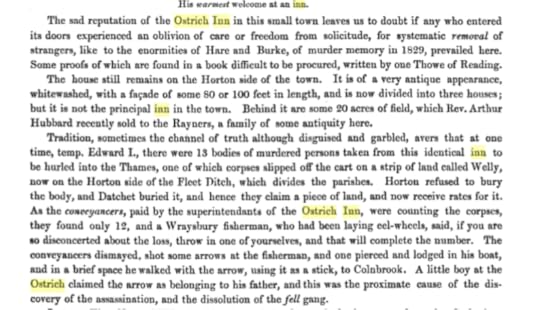 Snippet from Gyll’s book, from Google Books
Snippet from Gyll’s book, from Google BooksGyll says that the murders took place in the 13thC in the reign of Edward I, where the innkeeper murdered his guests (presumably to rob them). The pictured inn above is the Tudor-fronted version, as opposed to the 13thC original front.
Sweeney Todd, the Demon Barber of Fleet StreetSweeney Todd is a fictional character who first appeared as the villain of the penny dreadful serial The String of Pearls (1846–47). The serial was so popular that a play based on it was written and performed at the Britannia Theatre, London, before the serial even came to a close. The original story is set during the youth of George III, so the mid-1700s, but many adaptations tend to put it in the reign of Queen Victoria.
The serial was so popular that some people really believed that it must be based on a real person or real events, but this is unlikely.
The 2005 BBC drama starring Ray Winstone placed the action back in the 1760s and make it less of a melodrama and more realistic, as if telling the “real story” behind the melodrama, even though it’s the “real story” of a man who never existed.
This was a choice to move away from the popular Sondheim musical (first opened on Broadway in 1979 with a 2006 film adaptation dir. Tim Burton) that merged the concept of Sweeney Todd cutting throats of his customers for Mrs Lovett’s meat pies with the basic plot of THE COUNT OF MONTE CRISTO (Dumas) and THE REVENGER’S TRAGEDY (Middleton), which is the version of the story most people are now familiar with.
Scottish CannibalsAlexander “Sawney” Bean and his clan is one of the most famous and influential of the Scottish Cannibal tales.
Versions of this story were printed and disseminated as anti-Scottish, anti-Jacobite propaganda used to denigrate the Scots after the Jacobite rebellions, and debates rage about whether he was a real person. He was head of a clan of cannibals who allegedly killed thousands of people over a 25 year period, and was married to “Black Agnes” Douglas, allegedly a witch. The clan operated in East Lothian in the 16thC.
Here’s a version of the tale: SAWNEY BEANE An incredible Monster who, with his Wife, lived by Murder and Cannibalism in a Cave. Executed at Leith with his whole Family in the Reign of James I.
Allegations of cannibalism clung to the Douglas clan too: in the 18thC, James Douglas, (1697-1715), 3rd Marquis of Queensbury, known until 1711 as Earl of Drumlanrig, apparently killed and roasted a kitchen boy when he was 10 years old (1707) and was discovered eating him.
It’s worth noting that “Sawney” was a popular colloquial term for a Scotsman, like “Jock” in modern slang and “Taffy” for Welshmen, and was itself a Lowland Scots diminutive of Alexander (a popular name).
There are a couple of versions of the Sawney Bean tale but they all end with the capture and execution of Bean and his clan at the hands of King James VI of Scotland (also King James I of England). James [Stuart] ruled both countries in personal union. The Act of Union that formally united Scotland with England and Wales (Wales’s Act of Union had been under Henry VIII) was in 1707, and was supported by James Douglas’s father. The tale of the young Douglas spit-roasting another lad and eating him is set at the celebrations for the 1707 Act of Union, and was used by the opposition to say that the Douglases got what they deserved for supporting it (namely, a child with severe mental instability and cannibal tendencies).
The tale is also related to at least two other tales from the Middle Ages, including Andrew Christie “Christie-Cleek”, a mid-14thC butcher from Perth, who turned to cannibalism during a famine (probably the 1340s). He and his gang were located in the Grampians, and his tale is recorded in a few collections of folklore including John Mackay Wilson, Tales Of The Borders, And Of Scotland (Edinburgh: James Gemmell, 1883) – you can jump straight to ‘Christie of the Cleek”s tale here.
In 1696, Nathanial Crouch, an English printer and bookseller who wrote/compiled history books under the name Richard Burton, included a Scottish tale from 1459, in which an infant of one year old was the surviving child of a cannibal brigand and raised by godly adopted parents, but at age 12 went back to cannibalism and was executed for it.
Crouch/Burton probably got this tale from Hector Boyce (or Hector Boethius, Boice, Boece), 1465–1536, a Scottish philosopher and historian, and rewrote/embellished it.
Sometimes, the tales of the cannibal child are tacked onto Sawney Bean versions and merged with that.
The Cannibal Witch of LlanberisThere are very few stories of cannibals in Wales and the most recent thing you’ll get if you search is the real-life (and recent) case from 2014, which went to trial in 2017, which is seriously upsetting, so only look that up if you really want to. The killer in that case did not eat his victim, though onlookers thought that’s what he was doing and that’s how it was reported in the media. It was refuted in 2017 reports after the autopsy details were made known, but he is still known as “the cannibal killer”.
While witches are ambiguous figures in Welsh folklore and fiction, which I’ve written about in a previous post (linked), there is a story of a cannibal witch in North Wales.
Canrig Bwt lived under a stone and ate the brains of children. Her story is collected in Wirt Sykes, British Goblins, 1881.

The relevant portion of the tale is short and reads:
A famous Welsh witch, who used to sleep under stone at Llanberis, in North Wales, was called Canrig Bwt, and her favourite dish at dinner- was children’s brains. A certain criminal who had received a death-sentence was given the alternative of attacking this frightful creature, his life to be spared should he succeed in destroying her. Arming himself with a sharp sword, the doomed man got upon the stone and called on Canrig to come out. “Wait till I have finished eating the brains in this sweet little skull”, was her horrible answer. However, forth she came presently, when the valiant man cut off her head at a blow. To this day they scare children thereabout with the name of Canrig Bwt.
The tale does not seem to appear in Marie Trevelyan’s Folk-Lore and Folk-Stories of Wales (1909). This is an interesting omission as Trevelyan includes a number of stories about witches in Wales, with a range of outcomes and involvement in events.
“Canrig” looks like an Anglicised corruption of “canwraig”, meaning “songstress”, while “bwt” is most likely the soft mutation of “pwt”, meaning a short thing/anything short, and is used colloquially in the sense of a soundbite or in place of the “wouldn’t give a penny for…” idiom and its variations.
L. T. Jones on YouTubeI love the really creepy idea of a singing woman living under a rock surrounded by skulls, eating the brains of little children. In some versions of the tale she is green-skinned which would link her to the fairy-lore, where the Gwyllion haunt mountain roads and often appear as hags. Exorcism by knife is a Welsh tradition (according to Sikes) as they are afraid of cold iron and it can banish them.
These are just a few, and I may do some other posts later for specifically creepy Welsh folklore. In the meantime check out my series of posts based around Jane Aaron’s Welsh Gothic (2013).



